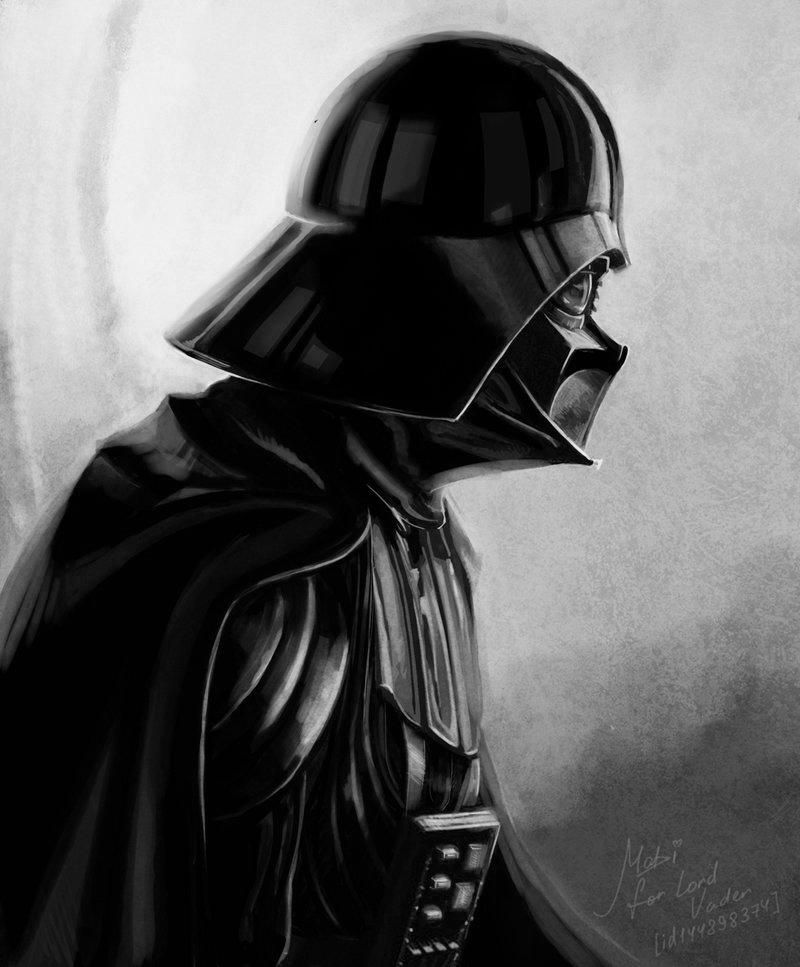It is within this steep downwards decline away from the
human comfort zone that sit zombies, puppets, clowns and other humanoid shaped
fears reside. The issue, according to the uncanny valley, is that these things
are so incredibly similar to what we consider a ‘normal human being’ and yet in
some way intrinsically different that they become unnatural to us. It is
therefore no surprise that content creators have used this psychological
phenomenon as a device to sow discomfort and the eerie feeling of ‘wrong’ into
audiences.
One example of the uncanny valley’s placehold in today’s
pop-culture lifestyle is an iconic face (or rather mask). This face is the Star
Wars saga’s ever memorable Sith Lord, Darth Vader. Whilst the beloved face of
the entire epic saga is known to be human under his daunting black armoured
exterior, the dark lord’s appearance is part of his chilling fear factor.
First in the many Uncanny Valley inducing aspects of Lord
Vader is his height. Whilst tall men can be very common, with tall gentlemen
even being regarded as an attractive trait, Vader’s daunting cybernetically
heightened build holds him at a grand 6’ 8”, a height that by most common
standards could be considered unnatural. This is not to say it’s impossible to
be near 7 feet tall but it is just tall enough to make the villain stand out as
something different to the other minions of the galactic empire; something
different. Darth Vader’s other traits merely add to this atmosphere of unnaturalness,
the mechanical breathing reminiscent to a hospital patient and the unmoving,
emotionless, skull like face he is so well remembered for. It is safe to say
that as examples go, the Uncanny Valley is strong in this one.
Masahiro’s Valley is also a key necessity in understanding the
incredibly huge appeal for zombie horror franchises. George A. Romero’s Night of the Living Dead, Dead Rising
and the Walking Dead, all big names that found success in the iconic universe
of the zombie apocalypse. But why are zombies such a staple creature in the
halls of horror writing and how does the Uncanny Valley at all apply to
shambling corpses? Arguably, it is because ‘creature’ is far from the right word
to describe the living dead. The unnerving aspect of the infected humans,
doomed to rise and devour the flesh of the living is that these monsters that
stand so far apart from human’s with their mindless hunger are merely a bite
away from what we are as living beings. Whilst some monsters are terrifying for
their impossibility such as the creations of H. P. Lovecraft, the zombie is at
its core so parallel to us yet made what it is by things that instinctively
repulse us, death and cannibalism, but apart from these differences they are
exactly like ourselves. Fear is spawned in us by the sheer possibility of an
infectious zombie outbreak as whilst not many people have a backup plan for
Mi-go descending from space or Cthulhu rising from the depths it is so common
to have a ‘zombie apocalypse plan’ because whilst it is known fact that zombies
are merely fiction there’s that nagging feeling that lasts at the end of the
film. The feeling of ‘could it happen’?
 Lastly, a very recent example of the Uncanny Valley’s
presence in today’s pop culture is the hugely popular Japanese anime Shingeki
no Kyojin or Attack or Titan. In the battle against the destructive titans
humanity is beset by some truly grim sights. The titans resemble towering naked
humanoids whose only goal is devouring the remnants of the walled of civilisation
of humans. The Uncanny Valley sets off alarms at every turn with this gore
packed action series with the human resemblance of the giant monsters so
uncanny (bar their genderless form) that their every inhuman movement and
interaction leaves a visceral reaction of discomfort in a great many fans. It
is this, paired with the shows pull-no-punches attitude to death of the human
characters that creates such a profound sense of horror throughout the anime
and manga that has caught the attention of thousands of dedicated fans.
Lastly, a very recent example of the Uncanny Valley’s
presence in today’s pop culture is the hugely popular Japanese anime Shingeki
no Kyojin or Attack or Titan. In the battle against the destructive titans
humanity is beset by some truly grim sights. The titans resemble towering naked
humanoids whose only goal is devouring the remnants of the walled of civilisation
of humans. The Uncanny Valley sets off alarms at every turn with this gore
packed action series with the human resemblance of the giant monsters so
uncanny (bar their genderless form) that their every inhuman movement and
interaction leaves a visceral reaction of discomfort in a great many fans. It
is this, paired with the shows pull-no-punches attitude to death of the human
characters that creates such a profound sense of horror throughout the anime
and manga that has caught the attention of thousands of dedicated fans.
In conclusion the Uncanny Valley, whilst originally born
from a theory of robotics, has soaked the entire field of horror with a
flawless method of birthing dread in the hearts of film fans, tv, anime and
literary buffs across the globe. And with the track history for the tried and
true method it will be no surprise to see this theory proven time and time
again in the years to come in all areas of storytelling media. However do not
misread into that and assume here at Pop Culture Bang the uncanny value is
looked forward to with excitement; it is anticipated with dread in our hearts,
for all of the right reasons.


